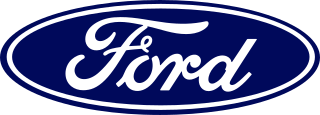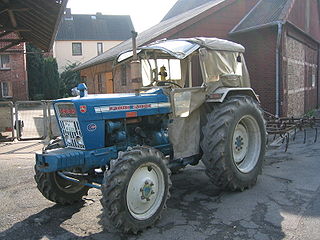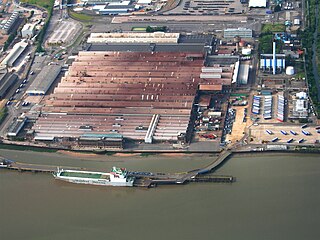
The Ford Model T is an automobile that was produced by the Ford Motor Company from October 1, 1908, to May 26, 1927. It is generally regarded as the first mass-affordable automobile, which made car travel available to middle-class Americans. The relatively low price was partly the result of Ford's efficient fabrication, including assembly line production instead of individual handcrafting. The savings from mass production allowed the price to decline from $780 in 1910 to $290 in 1924. It was mainly designed by three engineers, Joseph A. Galamb, Eugene Farkas, and Childe Harold Wills. The Model T was colloquially known as the "Tin Lizzie".

Ford Motor Company of Australia Limited is the Australian subsidiary of United States-based automaker Ford Motor Company. It was founded in Geelong, Victoria, in 1925 as an outpost of Ford Motor Company of Canada, Limited. At that time, Ford Canada was a separate company from Ford USA. Henry Ford had granted the manufacturing rights of Ford motor vehicles in the British Empire, to Canadian investors.

Ford Motor Company of New Zealand Limited is the New Zealand subsidiary of Ford Motor Company. The Ford-New Zealand assembly and distribution began in 1936, following the successful representation of Ford's New Zealand business by The Colonial Motor Company (CMC). Ford-New Zealand was based in Seaview, Wellington. A second assembly plant was opened in Wiri, Auckland in 1973. The head office was moved to Auckland before Seaview was closed in 1988 and, in 1997, vehicle production at Wiri came to an end. Since then, all of the Ford-New Zealand product offerings have been fully imported.

Fordson was a brand name of tractors and trucks. It was used on a range of mass-produced general-purpose tractors manufactured by Henry Ford & Son Inc from 1917 to 1920, by Ford Motor Company (U.S.) and Ford Motor Company Ltd (U.K.) from 1920 to 1928, and by Ford Motor Company Ltd (U.K.) from 1929 to 1964. The latter also later built trucks and vans under the Fordson brand.

Henry George Ferguson was an Irish mechanic and inventor who is noted for his role in the development of the modern agricultural tractor and its three point linkage system, for being the first person in Ireland to build and fly his own aeroplane, and for developing the first four-wheel drive Formula One car, the Ferguson P99.

The Ford River Rouge complex is a Ford Motor Company automobile factory complex located in Dearborn, Michigan, along the River Rouge, upstream from its confluence with the Detroit River at Zug Island. Construction began in 1917, and when it was completed in 1928, it was the largest integrated factory in the world, surpassing Buick City, built in 1904.

Ford Motor Company Limited, trading as Ford of Britain, is a British wholly owned subsidiary of Ford Technologies Limited, itself a subsidiary of Ford International Capital LLC, which is a subsidiary of Ford Motor Company. Its business started in 1909 and has its registered office in Laindon, Essex. It adopted the name of Ford of Britain in 1960.

The Ford N-series tractors were a line of farm tractors produced by Ford between 1939 and 1952, spanning the 9N, 2N, and 8N models.

Ford-Werke GmbH is a German-based car manufacturing factory headquartered in Niehl, Cologne, North Rhine-Westphalia. It is a fully owned subsidiary of American Ford Motor Company, which operates two large manufacturing facilities in Germany, a plant in Cologne and a plant in Saarlouis and serves as a major hub for the Automaker's presence in the European markets.

Ford of Europe GmbH is a subsidiary company of Ford Motor Company founded in 1967 in Cork, Ireland, with headquarters in Cologne, Germany.

The Ford 5000 is a blue and white tractor that was produced from 1964 to 1979 by Ford. It was a mid-range tractor, suitable for European farms. The North American version was slightly different and was named the Ford Major. A similar model, the Ford 3000 was introduced in the spring of 1965.

Ford Dagenham is a major automotive factory located in Dagenham, London, operated by the Ford of Britain subsidiary of Ford Motor Company. The plant opened in 1931 and has produced 10,980,368 cars and more than 39,000,000 engines in its history. It covers around 475 acres and has received over £800 million of capital investment since 2000.

Samson Tractor was an American brand of tractors 1900 to 1923, of trucks from 1920 to 1923, and a General Motors brand from 1917 to 1923.
Ford Trafford Park Assembly Plant was a car assembly plant established by Ford of Britain at Trafford Park, beside the Manchester Ship Canal, a short distance to the west of Manchester. It was the first manufacturing plant established by Ford outside the United States, though originally it was established merely to assemble vehicles using parts imported from Dearborn.

Ford Motor Company is an American multinational automobile manufacturer headquartered in Dearborn, Michigan, United States. It was founded by Henry Ford and incorporated on June 16, 1903. The company sells automobiles and commercial vehicles under the Ford brand, and luxury cars under its Lincoln brand. Ford also owns a 32% stake in China's Jiangling Motors. It also has joint ventures in China, Taiwan, Thailand, and Turkey. The company is listed on the New York Stock Exchange and is controlled by the Ford family; they have minority ownership but the majority of the voting power.

The Ford Mondeo I (first generation) is a mid-size car that was produced by Ford, beginning on 23 November 1992, with sales beginning on 22 March 1993. It is also known as the Mk I Mondeo; the 1996 facelift versions are usually designated Mk II. Available as a four-door saloon, a five-door hatchback, and a five-door estate, all models for the European market were produced at Ford's plant in the Belgian city of Genk. In December 1992, Autocar published a section on the Mondeo, and how it would conquer rivals.

The fourth generation of the Ford Mondeo, is a range of mid-size cars produced by Ford from 2013 to 2022. Developed under the model code CD391, it is a rebadged variant of the American-market Fusion sold in Europe, Latin America, China and Australia. Revealed at the 2012 North American International Auto Show in Detroit, Michigan, the Mondeo is based on a new iteration of Ford's C/D platform, which it shares with the Galaxy and S-Max large MPVs. The Fusion had started production in 2012, which was about one year before the Mondeo had. At its launch, it served as the flagship model for Ford's lineup in China, and was tested on Chinese roads in 2013.
The automotive industry in Ireland has had a varied history. The punitive tax on imported cars encouraged a wide range of companies to assemble their cars locally including Fiat, Ford and Renault. From Ireland's entry to the European Union in 1973, the need for locally produced cars to avoid import taxes reduced and since the 1980s, production ended and all cars are now imported.

Changan Ford is a Chinese automotive manufacturing company headquartered in Chongqing. It is a 50/50 joint venture between local Changan Automobile and US-based Ford Motor Company. The company's principal activity is the manufacture of Ford brand passenger cars for the Chinese market. The company was formed in December 2012 after the decision to restructure Changan Ford Mazda, whereby Ford and Mazda agreed to work with Changan as separate joint ventures. Currently, Changan Ford's entire production base is the largest manufacturing location outside Detroit, Michigan for Ford. It has plants in Chongqing, Hangzhou & Harbin.

Thames was a commercial vehicle brand produced by Ford of Britain.























